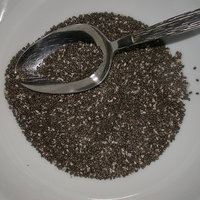
The Chia Seed
You might remember chia from the Chia Pet commercials, (“Ch-ch-ch-chia!”) and seeing the chia sprout as fluffy green hair atop a small clay pot or figure. But chia, like the flax seed, really is a “super seed!” And it’s growing in popularity once again because of its amazing nutritional super powers.
What is Chia?
Chia is a small seed that was popular centuries ago among the Mayan, Aztec and Incan cultures because of its ability to increase stamina and energy over long periods of time.
Chia seeds were considered “Indian Running Food” because they were taken along on long journeys for sustenance. In fact, the word “chia” is the Mayan word for “strength.”
The chia seed is derived from a flowering plant in the mint family called the “Salvia hispanica,”native to Mexico and Guatemala. The seeds are white or black and can be ground up, but unlike the flax seed, it is not necessary to grind chia seeds to maximize its nutritional potential. Also, the FDA recognizes chia as a real “food,” not a nutritional supplement.
The Benefits of Chia
It’s no accident that the chia seed is considered a super food. It’s small, but it packs an amazing nutritional punch. It’s even far superior to the flax seed!
Chia seeds can absorb up to 12 times its size in water, so when added to food or beverages, chia seeds are both filling and hydrating. Chia seeds are gluten-free and they also contain protein, are rich in vitamin c, potassium, and contain more iron than spinach! But wait –there’s more, just look at the chia seed’s lengthy resume!
Protein: Chia seeds are made up of about 20% protein, which is higher than other grains and seeds. The combination of protein and carbohydrates allows chia to be digested slowly. While the protein helps to boost energy, the slow digestion aids in endurance, making it quite popular among athletes.
Omega-3: Chia seeds have eight times more omega-3 fatty acids than salmon! Omega-3s help balance out the ratio of omega-6 and omega-3 fatty acids, which can also reduce stress and inflammation in the body. Omega-3 also helps with cognitive function, so with 8 times more than salmon, that’s a lot of brain power!
Omega-6: Omega-6 fatty acids help lower the bad cholesterol and raise the good levels. They also help reduce cancer risk!
Antioxidants: Chia seeds contain more immune-system boosting antioxidants than even blueberries!
Fiber: The chia seed is one of the richest sources of soluble fiber, which helps to lower blood pressure, decrease inflammation, and aid in digestion.
Calcium: Chia contains 5 times more calcium than milk!
In addition to the nutrients the chia seed boasts, chia seeds have been known to help with the following ailments:
Diabetes: Studies show that the soluble fiber in chia seeds helps to regulate glucose levels making it a great food for diabetics.
Irritable Bowel Syndrome (IBS): Chia is not only a source of fiber, it is considered a “hydrophilic” food because it can absorb up to 12 times its weight in water. That means chia seeds not only hydrate the body, they irrigate the intestines as they pass through, aiding the flow of the digestive tract and promoting regularity.
Arthritis: Because of the high levels of essential fatty acids, chia seeds can reduce inflammation, which help with conditions such as arthritis and rheumatoid arthritis.
Chia for Weight Loss
Chia seeds are made up of proteins, soluble fiber, and carbohydrates. They are slowly digested, which can make a person feel full for longer, warding off hunger and cravings and promote fat burning. Adding chia seeds or chia gel to foods can help bulk up foods without adding extra calories, helping to promote weight loss or maintenance.
Uses for Chia
Chia seeds can be added to shakes, smoothies, beverages, water, baked goods, puddings and other recipes as well as sprinkled onto most any food. They can be consumed whole or ground, but grinding them does not affect its nutritional value. Chia seeds can also be used to make a chia gel when added to water. Chia gel can be consumed on its own or added to recipes in place of eggs or butter, or as an extender for sauces or dressings. By itself, chia gel is flavorless, but chia’s absorption capabilities allow it to magnify the existing taste of foods! Click here for the recipe to make chia gel.
You can even put chia seed in your pet’s food to aid in their digestion!
Chia seeds keep for a long time, too. When kept at room temperature, chia seeds will last for up to 5 years. Chia gel lasts for up to two weeks when refrigerated.
How to Choose the Right Chia Seed
There are a wide variety of chia seeds on the market from white to black seeds, grown in a variety of different regions and climates.
So which chia seed is best?
While the nutrition of the white and black seeds is almost identical, studies show that the darker chia seeds contain more antioxidants.
Chia seeds come from the “Salvia hispanica” plant, native to Mexico but also grown in South America.
Studies show that chia seeds grown at higher elevations, cooler temperatures, and drier conditions are the most nutritious and contain the most omega-3 and omega-6 fatty acids, than other climates.
So make sure you to get the most out of your chia seed!


I have been eating ground flax seed in my oatmeal for several months,in part,because I like the taste and texure. After reading your website on chia, I’ve decided to try it. Does one duplicate, or supplement, the other?
Hey there. Chia seeds and flax seeds both have a lot of fiber and minerals so they’re great to add to cereals and shakes, but chia has more omega-3 fatty acids, calcium, and antioxidants. The major downside of flax seed is one of its main components is lignan. Lignan is one of the major classes of phytoestrogens, or chemicals in plants which are estrogen-like. Flaxseed contains 75 to 800 times more lignans than other plant foods according to WebMD. [1]
Phytoestrogens, like lignan, “can be beneficial to postmenopausal women or women with certain hormonal imbalances. However, since most of us already have more estrogen than we need and not enough progesterone, we should probably limit our flax consumption. Men might consider avoiding it all together. It is also important to note that one study shows pregnant women who consume flax oil quadrupled their rates of premature labor.” [2]
[1]
http://www.webmd.com/diet/features/benefits-of-flaxseed
[2]
http://www.realfoodallergyfree.com/2011/05/which-is-better-chia-or-flax/
Great to have your research on hand. Since I’m a man (old at that) I’ll wouldn’t replenish my flax, but use chia instead. Thanks for info and availability.